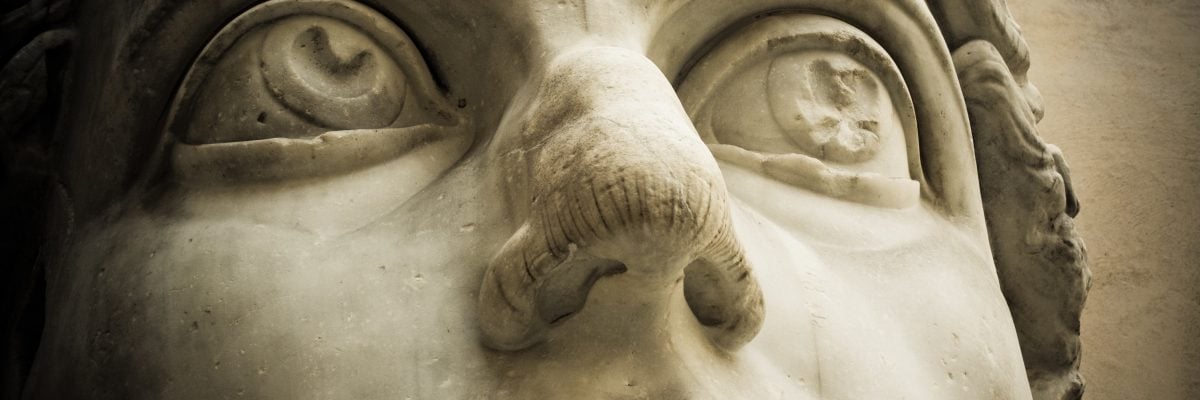
Some people claim the Catholic Church came into existence in the early part of the fourth century after the Roman emperor Constantine (pictured above) converted to Christianity. Reformed writer Lorraine Boettner presents one such scenario:
[I]n the fourth century the emperor Constantine, who was the ruler in the west, began to favor Christianity, and then in the year 324, after he had become ruler of all the Empire, made Christianity the official religion. The result was that thousands of people who were still pagans pressed into the church in order to gain the special advantages that went with such membership. . . . Gradually, through the neglect of the Bible and the ignorance of the people, more and more heathen ideas were introduced until the church became more heathen than Christian (Roman Catholicism [1962]) 11).
There are two glaring errors in Boettner’s view of Church history. First, the emperor Constantine did not make Christianity the official religion of the Roman Empire. Constantine did enact the Edict of Milan in A.D. 313, but that only granted legal toleration of the Faith. Christianity did not become the official religion of the empire until the reign of the Theodosius I in 380.
Second, Boettner ignores the fact that “heathen ideas” like the real presence of Christ in the Eucharist or the necessity of baptism can be seen in the writings of early Church Fathers such as Justin, Irenaeus, Cyprian, Tertullian, and others who lived long before Constantine’s reign. Even Protestant scholars admit that the doctrine of baptismal regeneration, or the teaching that baptism actually removes the stain of original sin, was promulgated long before the time of Emperor Constantine. According to Reformed apologist William Webster:
The doctrine of baptism is one of the few teachings within Roman Catholicism for which it can be said that there is a universal consent of the Fathers . . . From the early days of the Church, baptism was universally perceived as the means of receiving four basic gifts: the remission of sins, deliverance from death, regeneration, and the bestowal of the Holy Spirit (The Church of Rome at the Bar of History, 95-96).
Critics like Boettner also fail to understand that the Church, guided by the Holy Spirit, is capable of baptizing pagan rites and using them in service of the gospel. This is called inculturation, which is a process that Pope St. John Paul II describes in this way:
Through inculturation the Church makes the gospel incarnate in different cultures and at the same time introduces peoples, together with their cultures, into her own community. She transmits to them her own values, at the same time taking the good elements that already exist in them and renewing them from within.Through inculturation the Church, for her part, becomes a more intelligible sign of what she is, and a more effective instrument of mission (Redemptoris Missio 52).
In the nineteenth century, Henry Cardinal Newman pointed out that many rituals in the Church have a non-Christian origin. The following quote that is attributed to him can be found on multiple Fundamentalist websites:
Temples, incense, oil lamps, votive offerings, holy water, holidays and season of devotions, processions, blessing of fields, sacerdotal vestments, the tonsure [of priests and monks and nuns], images . . . are all of pagan origin.[i]
Notice how this quote contains carefully placed ellipses that indicate a portion of it has been excised. The missing part contains the phrase, “the ring in marriage,” which was left out because Protestants routinely engage in this custom during their wedding services. The Bible knows nothing of wedding rings, but they were common in places like ancient Egypt, because they symbolized eternity and were worn on the finger that purportedly contained a nerve that extended all the way to the heart (Philippe Ariès and Georges Duby [eds.], A History of Private Life: From Pagan Rome to Byzantium, 467).
If the Catholic customs of using incense, candles, and chants contain an unforgivable infusion of “heathenism” into the Church, then Protestant churches that use fog machines, stage lights, and rock and roll music are just as heathen. Baptist harvest festivals celebrated on or just after Halloween would be another example of Protestant inculturation, since they celebrate morally good or morally neutral activities such as communal fall festivities or giving out candy without endorsing morally evil things like the occult.
John Paul II taught that using cultural elements in service of the gospel is not wrong as long such elements “in no way compromise the distinctiveness and integrity of the Christian faith” (Redemptoris Missio 52).
[i] See for example http://www.ucgoc.com/bs2/32Lev19-23.htm. The unabridged quote can be found in chapter eight of Cardinal John Henry Newman’s Essay on the Development of Christian Doctrine.



